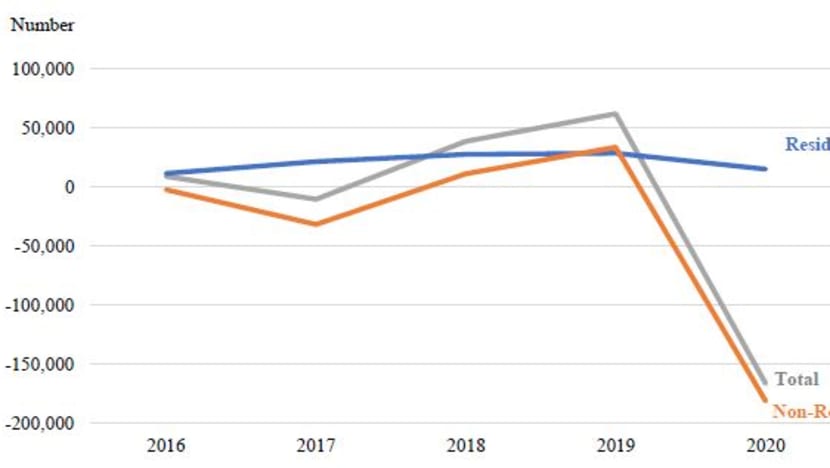Singapore's sharpest fall in employment in more than 20 years borne by non-resident workers: MOM

People walk during their lunch break in the financial business district of Raffles Place in Singapore on Jan 11, 2021. (Photo: AFP/Roslan RAHMAN)
SINGAPORE: Singapore recorded its sharpest fall in total employment in more than two decades in 2020, with non-resident workers accounting for all of the employment decline, said the Ministry of Manpower (MOM) on Tuesday (Mar 16).
Total employment, excluding foreign domestic workers, contracted by 166,600 last year, according to the Labour Market Report 2020 released on Tuesday. The number of employed non-residents fell by 181,500 last year.
Resident – Singaporeans and permanent residents – employment grew by 14,900, and rebounded to “slightly above pre-COVID levels” as a result of improvements in the second half of the year.
The decline is the largest since public records started in 1991, with the next largest fall of 30,600 seen in 1998 during the Asian Financial Crisis.
“I think in the forthcoming months, we see that the economy has turned the corner, the job market has turned the corner, but I think it is wise for us to keep in mind that the risk factors do remain,” said Manpower Minister Josephine Teo, commenting on the Labour Market Report after a visit to Giant Hypermart in Tampines.
Unemployment rates have fallen since November and have continued to fall in December and January this year, she added. The number of workers on short work-weeks or temporary lay-offs continued to fall, from 34,240 in the third quarter of 2020 to 8,710 in the fourth quarter, according to the report.
Elaborating on the risk factors, Mrs Teo said that borders are still not reopening significantly and that will weigh on an externally connected economy like Singapore’s.
She also cautioned that some Government support schemes such as the Jobs Support Scheme are tapering off, even as other schemes, such as the Jobs Growth Incentive, are picking up speed.
“Some support level is still there, but nonetheless, we have to watch what happens to the job market as these schemes transferred from one to the other,” she said.
She also highlighted that as people move into new jobs, there will always be some “friction”, as both job seekers and employers evaluate if they are the “right fit” for each other.
“The SG United Traineeship as well as the company attachment programme essentially is to try and bridge these kinds of gaps where both jobseeker and employer are not very sure about each other,” she said.
“This is the whole idea: To try and make those job matches happen.”

Resident employment trends were mixed across different sectors, with the largest contractions in tourism and aviation-related sectors, which were severely affected by travel restrictions and safe distancing measures. Resident employment grew in some industries, including public administration and education, health and social services, as well as finance and insurance services.
Non-resident employment fell in all sectors, with the bulk in construction and manufacturing. The decline was mainly driven by holders of work permits and other work passes, said MOM, with a decrease of 138,800. This was followed by a fall of 26,000 S pass holders and 16,700 employment pass holders.
READ: Economists upgrade Singapore’s 2021 GDP growth forecast to 5.8%: MAS survey
Overall unemployment rate rose from 2.3 per cent in 2019 to 3 per cent in 2020. Resident unemployment also grew from 3.1 per cent in 2019 to 4.1 per cent in 2020, while citizen unemployment went up from 3.3 per cent in 2019 to 4.2 per cent in 2020.
Although the annual average unemployment rates rose in 2020 compared to 2019, they did not exceed levels recorded during the SARS epidemic in 2003 and the global financial crisis in 2009. In the last two months of 2020, monthly unemployment rates had started to fall, said MOM.
"We're not out of the woods yet, but we see broad improvements in the labour market," said Mr Aubeck Kam, Permanent Secretary for MOM.
RETRENCHMENTS RISE
The number of retrenchments for the whole of 2020, at 26,110 workers, was more than double of 2019, when there were 10,690 retrenchments.
But the incidence of retrenchment in 2020, at 12.8 retrenched per 1,000 employees, was lower than in past recessionary years, which averaged 22.5 per cent retrenched per 1,000 employees. This is after taking into account increases in the size of the labour force over the years.
The rate of retrenchment for resident workers was 11.1 per 1,000 resident employees while the rate of non-resident workers being retrenched was 15.7 per 1,000 non-resident employees.
Overall, the re-entry rate among retrenched residents in 2020 was 62 per cent, slightly lower than 64 per cent in 2019, although there was an improvement in the final quarter of the year, said MOM.
The impact of the retrenchments varied across industries, age and gender.
The report said that the pandemic had a larger impact on industries with a higher concentration of non-PMETs (professionals, managers, executives and technicians), such as in retail, accommodation and food and beverage services.
Singaporeans and permanent residents working as clerical, sales and service workers were most prone to retrenchments in 2020.
Resident workers with educational qualifications of secondary and below saw a "much sharper increase in the incidence of retrenchment than other educational groups" over the year, said the report.
Mrs Teo said that in Singapore the recovery in the labour market has been "quite broad-based", with rank-and-file resident workers also getting back to work in recent months.
"We are quite mindful of the fact that it may still not be their preferred jobs ... at the point in time when we were dealing with this in 2020, it was more important to help them to stay in the workforce than to be forced to exit," she said.
Among resident workers, women were also more prone to retrenchment than men in 2020, unlike preceding years when men typically had a higher incidence of retrenchment, said the report.
"This was due to an increase in female share of resident retrenchments (from 45 per cent to 50 per cent) over the year, mainly in arts, entertainment and recreation and retail trade, industries which were more affected by COVID-19 measures and where females were over-represented," added the report.
The MOM report also found older residents in their 50s were most prone to retrenchment, relative to other age groups. While all age groups saw a broad-based increase in the incidence of retrenchment over the year, older residents aged 50 and over, as well as younger ones aged below 30 saw the largest increase.
The number of seasonally-adjusted job vacancies rose to 56,500 in December 2020, a high last seen in March 2019.
“This partly reflects the government support measures to encourage hiring,” said MOM.
READ: Budget 2021: Jobs Support Scheme extended for worst-hit sectors as part of S$11 billion package
READ: Commentary: Singaporeans have more opportunities for jobs with Budget 2021
The Singapore economy is expected to see a gradual recovery over the course of the year, although the pace of recovery “is likely to be uneven across sectors”, it added.
“Labour market conditions remain uncertain although we have started 2021 on a firmer footing than in 2020,” said MOM. “Labour market recovery may be gradual and uneven across sectors.”















